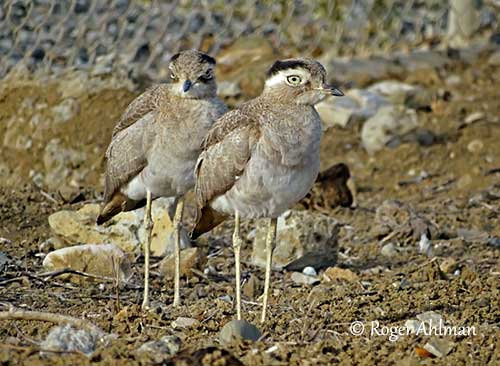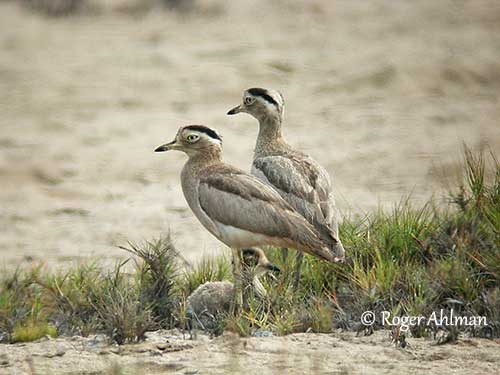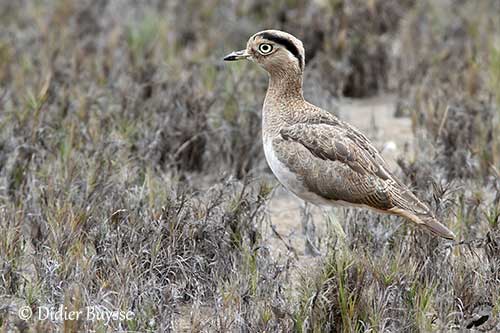
Fr: Œdicnème du Pérou
Ang: Peruvian Thick-knee
All: Peruanertriel
Esp: Alcaraván Peruano - Alcaraván Huerequeque
Ita: Occhione del Perù
Nd: Peruaanse Griel
Sd: perutjockfot
Photographers:
Roger Ahlman
Pbase Galleries Peru and Ecuador & My bird pictures on IBC
Didier Buysse
Vision d’Oiseaux
Dubi Shapiro
Dubi Shapiro Photo Galleries & Dubi Shapiro's Pictures on IBC
Simon Tan
PBase Bird galleries
Text by Nicole Bouglouan
Sources:
HANDBOOK OF THE BIRDS OF THE WORLD Vol 3 by Josep del Hoyo-Andrew Elliott-Jordi Sargatal - Lynx Edicions - ISBN: 8487334202
BIRDS OF PERU by Thomas S. Schulenberg, Douglas F. Stotz, Daniel F. Lane, John P. O’Neill, Theodore A. Parker III – Princeton University Press 2007– ISBN: 978-0-691-13023-1
Neotropical Birds – Cornell Lab of Ornithology
Wikipedia, the free encyclopaedia
CREAGUS@Monterey Bay (Don Roberson)
SciELO.org – Scientific Electronic Library Online
Peruvian Thick-knee
Burhinus superciliaris
Charadriiformes Order – Burhinidae Family
INTRODUCTION:
The Peruvian Thick-knee is found in a narrow coastal strip from N Chile, through Peru to N Ecuador, where it frequents semi-desert areas but also well-vegetated river-valleys.
It has mainly nocturnal habits and spends the day resting in an upright posture on the ground, well-camouflaged by its cryptic plumage.
This species is mainly terrestrial, but it is able to perform sustained flight. It feeds on insects and various invertebrates, small mammals, reptiles and bird’s eggs. It is sedentary throughout the range.
The Peruvian Thick-knee is not globally threatened, although destruction and fragmentation of the habitat in Ecuador may involve some decline of the population.

DESCRIPTION OF THE BIRD:
Biometrics:
Length: 40 cm (38-43 cm)
The Peruvian Thick-knee is fairly large with long legs. It is somewhat similar to a plover.
The upperparts are brownish-grey with brown streaking and spotting.
The underparts are whitish, but chin, throat and breast show pale buff vermiculations. Vent and undertail-coverts are pale buff.
The Peruvian Thick-knee may appear somewhat aberrant, with much plainer and greyer plumage overall than other Burhinus species.
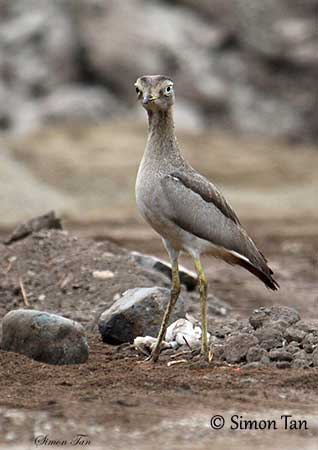
The head shows a broad, white supercilium, bordered above by a blackish stripe. Rest of head is pale brownish-grey, similar to the upperparts.
The short bill has black tip and pale pinkish base of lower mandible. The eyes are pale greenish-white to yellowish-white, surrounded by narrow, white, feathered eyering. The long legs and the three forwards-pointing toes are yellowish.
Male and female are similar.
The juvenile has darker brown upperpart feathers with buff fringes.
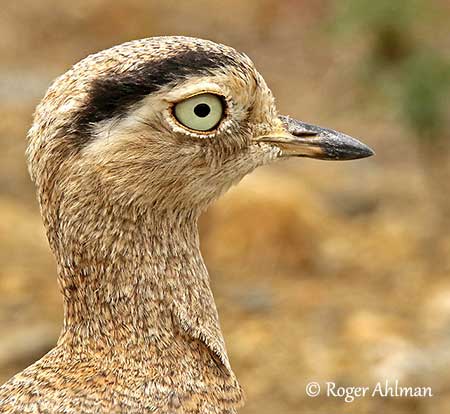
RANGE:
The Peruvian Thick-knee is found along the Pacific coast, from extreme S Ecuador to extreme N Chile.
In Ecuador, it occurs mainly in the SW lowlands in Santa Elena Peninsula near Huaquillas (El Oro) and in SW Loja near Zapotillo.
In Peru, it is common along the coast and the dry foothills of the Andes.
In Chile, it can be found in extreme N, in Arica and Putre provinces.
HABITAT:
The Peruvian Thick-knee frequents arid and semi-arid open coastal areas bordered by dry grasslands and open cultivated fields. It can be seen in vegetated river-valleys in desert, but it favours open corn fields and crops of alfalfa or others.
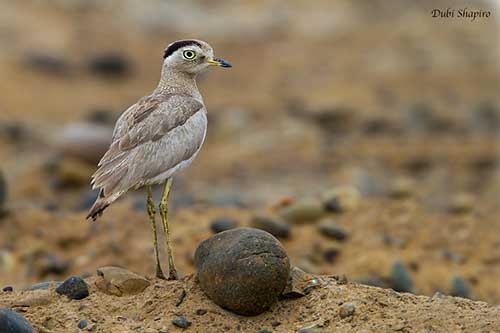
CALLS AND SONGS: SOUNDS BY XENO-CANTO
The Peruvian Thick-knee is usually silent during the day, becoming vocal and active at dusk. This species is locally named “Huerequeque” in a transliteration of its voice.
The alarm call is a series of nasal notes “ka-ka-ka-ka…ka-ka-ka-ka”. This call may become stronger when the bird is flushed “ka-ka-ka-kah”.
During the displays, and especially the nocturnal flight display, the bird produces loud series of “kak” notes.
The calls are usually penetrating and far-carrying.
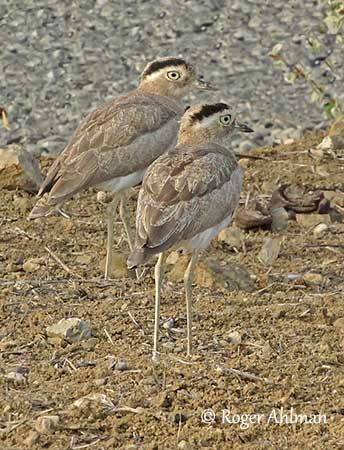
BEHAVIOUR IN THE WILD:
The diet of the Peruvian Thick-knee is poorly known, but the Burhinus species show some uniformity about their food.
It feeds primarily on insects, but it also probably takes small prey such as lizards, crustaceans, molluscs, worms, rodents and frogs, and also bird’s eggs.
It forages near water and up to 2-3 kilometres away from the coast. It picks up prey from the ground with the bill while walking forwards. It moves slowly, with short pauses before to catch a prey.
Larger, more active prey involve a short, quick run. Some flying insects are caught in the air with brief jumps from the ground to snatch them.
The Peruvian Thick-knee feeds after dusk. It can be found in flocks of up to 10-12 individuals.
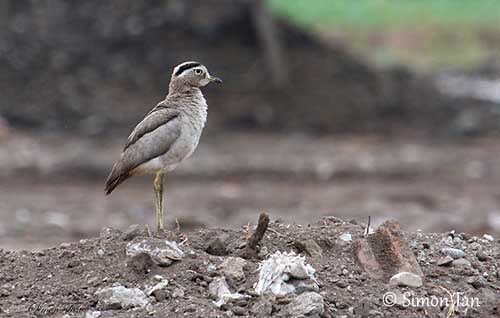
This species performs courtship displays after dark. Some observations of Burhinus species describe a male performing short runs, skips and leaps with open wings in front of a female. Both mates communicate through visual and vocal contacts throughout the breeding period. They are probably monogamous.
Other displays are performed during the nest-selection, with bowing, head and neck pointing downwards. Several sites are investigated, with the male calling the female to a scrape where she kicks earth backwards with her feet. Both mates may sit together near the scrape for long periods.
Prior to the copulation, the birds run towards each other and adopt a very upright stance. The tail is pointed downwards and the neck arched, while head and bill point down to the ground. This “neck-arch” display is used prior to the copulation. Both parents share the nesting duties.
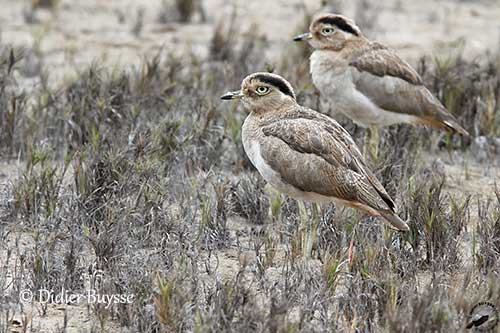
The Peruvian Thick-knee is sedentary in the range.
It is mainly terrestrial but it is able to perform strong, sustained flight. It usually prefers to run to escape a danger, but it can take flight immediately if necessary.
REPRODUCTION OF THIS SPECIES:
From the observation of two nests, each with two eggs in extreme N Peru in June 1978 and May 2012, the eggs are laid during this period.
However, some other observations of chicks in October and November, and of immature in December, may indicate almost year-round breeding season.
The Peruvian Thick-knee appears to nest solitary, but they may form loose groups if suitable habitat is restricted.
One observed nest was a shallow depression on the ground, on a rocky slope with scattered clump of low shrubs and cacti, and sparse grasses. The scrape was cleared of debris.
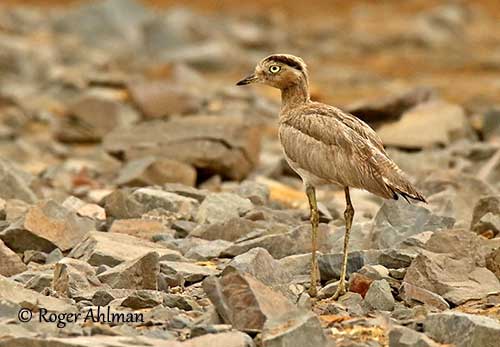
The clutch is apparently of two cryptic eggs, whitish buff with dark markings. In Burhinus species, both adults share the incubation during 24-27 days. The eggshells are removed from the nest after the hatching.
The precocial chicks have pale buff down and narrow black stripe on crown centre and behind the eye. They move from the nest 24 hours after hatching. Both parents guard them and feed them during the first days. If a predator approaches, they remain motionless and lie flat on the ground.
PROTECTION / THREATS / STATUS:
The Peruvian Thick-knee has fairly restricted range in which it is described as “very popular” with local people, probably due to its nocturnal habits and calls.
The species is affected by destruction and fragmentation of the habitat in Ecuador.
But currently, the Peruvian Thick-knee is not globally threatened and the species is evaluated as Least Concern.
